CHEVROLET CORVETTE 1998 5.G User Guide
Manufacturer: CHEVROLET, Model Year: 1998, Model line: CORVETTE, Model: CHEVROLET CORVETTE 1998 5.GPages: 378, PDF Size: 19.91 MB
Page 11 of 378
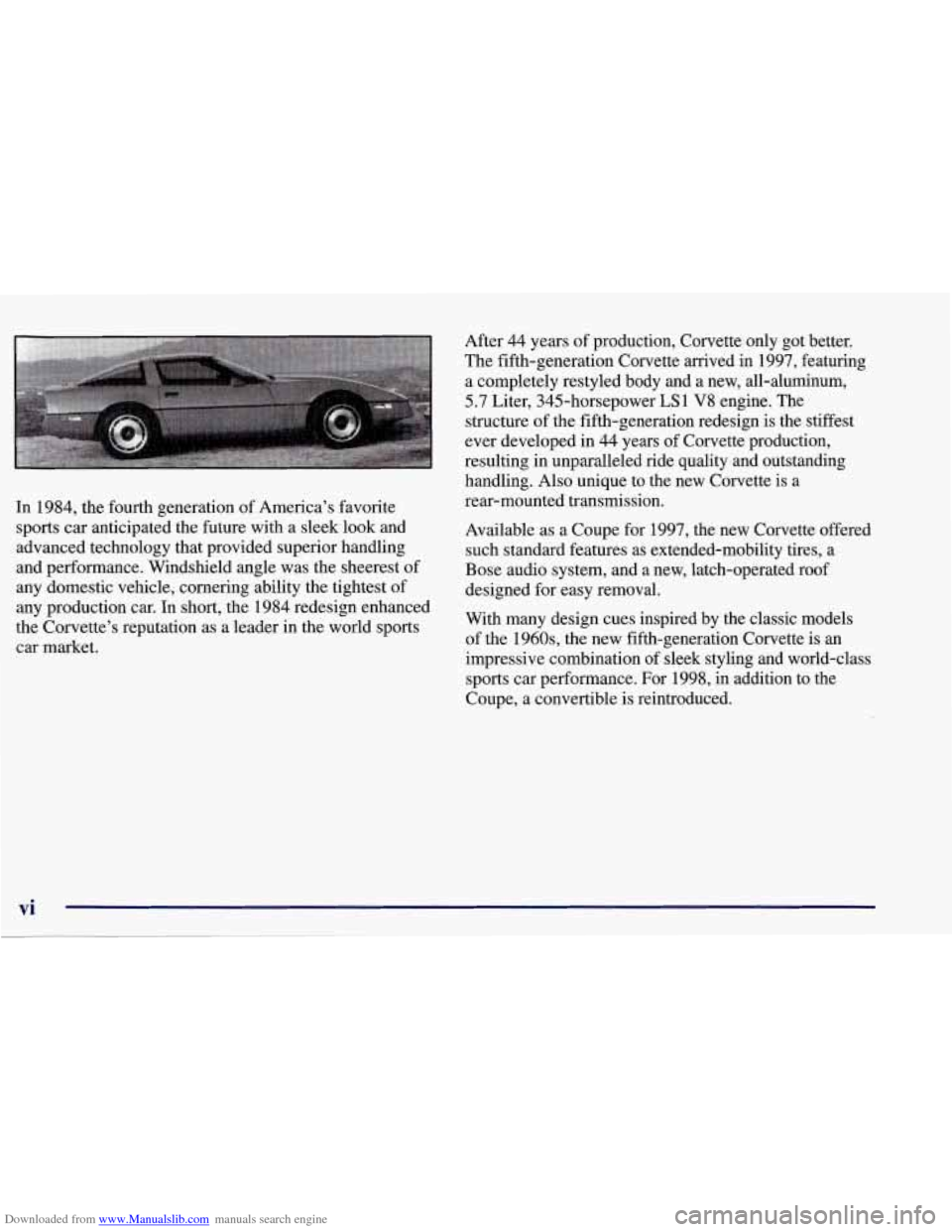
Downloaded from www.Manualslib.com manuals search engine In 1984, the fourth generation of America’s favorite
sports car anticipated the future with a sleek look and
advanced technology that provided superior handling
and performance. Windshield angle was the sheerest of
any domestic vehicle, cornering ability the tightest of
any production car. In short, the 1984 redesign enhanced
the Corvette’s reputation as a leader in the world sports
car market. After
44 years
of production, Corvette only got better.
The fifth-generation Corvette arrived in 1997, featuring
a completely restyled body and a new, all-aluminum,
5.7 Liter, 345-horsepower LS1 V8 engine. The
structure of the fifth-generation redesign is the stiffest
ever developed in 44 years of Corvette production,
resulting in unparalleled ride quality and outstanding
handling. Also unique to the new Corvette is a
rear-mounted transmission.
Available as a Coupe for 1997, the new Corvette offered
such standard features as extended-mobility tires, a
Bose audio system, and
a new, latch-operated roof
designed for easy removal.
With many design cues inspired by the classic models
of the 1960s, the new fifth-generation Corvette is an
impressive combination of sleek styling and world-class
sports car performance. For 1998, in addition to the
Coupe, a convertible is reintroduced.
vi
Page 12 of 378
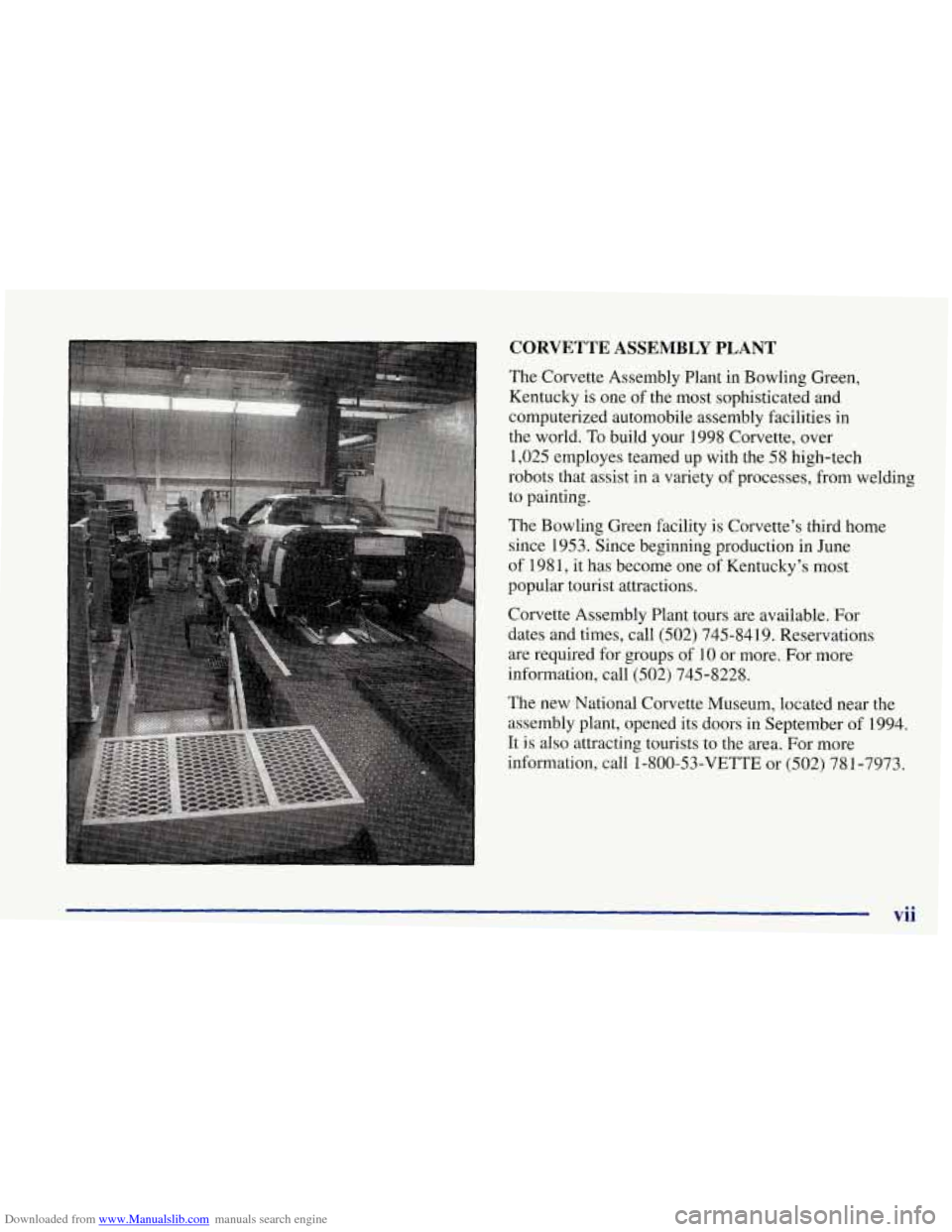
Downloaded from www.Manualslib.com manuals search engine CORVETTE ASSEMBLY PLANT
The Corvette Assembly Plant in Bowling Green,
Kentucky is one
of the most sophisticated and
computerized automobile assembly facilities in
the world.
To build your 1998 Corvette, over
1,025 employes teamed up with the
58 high-tech
robots that assist in a variety of processes, from welding
to painting.
The Bowling Green facility is Corvette’s third home
since 1953. Since beginning production in June
of 198
1, it has become one of Kentucky’s most
popular tourist attractions.
Corvette Assembly Plant tours are available. For
dates and times, call (502) 745-8419. Reservations
are required for groups of 10 or more. For more
information, call (502) 745-8228.
The new National Corvette Museum, located near the
assembly plant, opened its doors in September of 1994.
It
is also attracting tourists to the area. For more
information, call 1-800-53-VETTE or (502) 781-7973.
> vii
Page 13 of 378
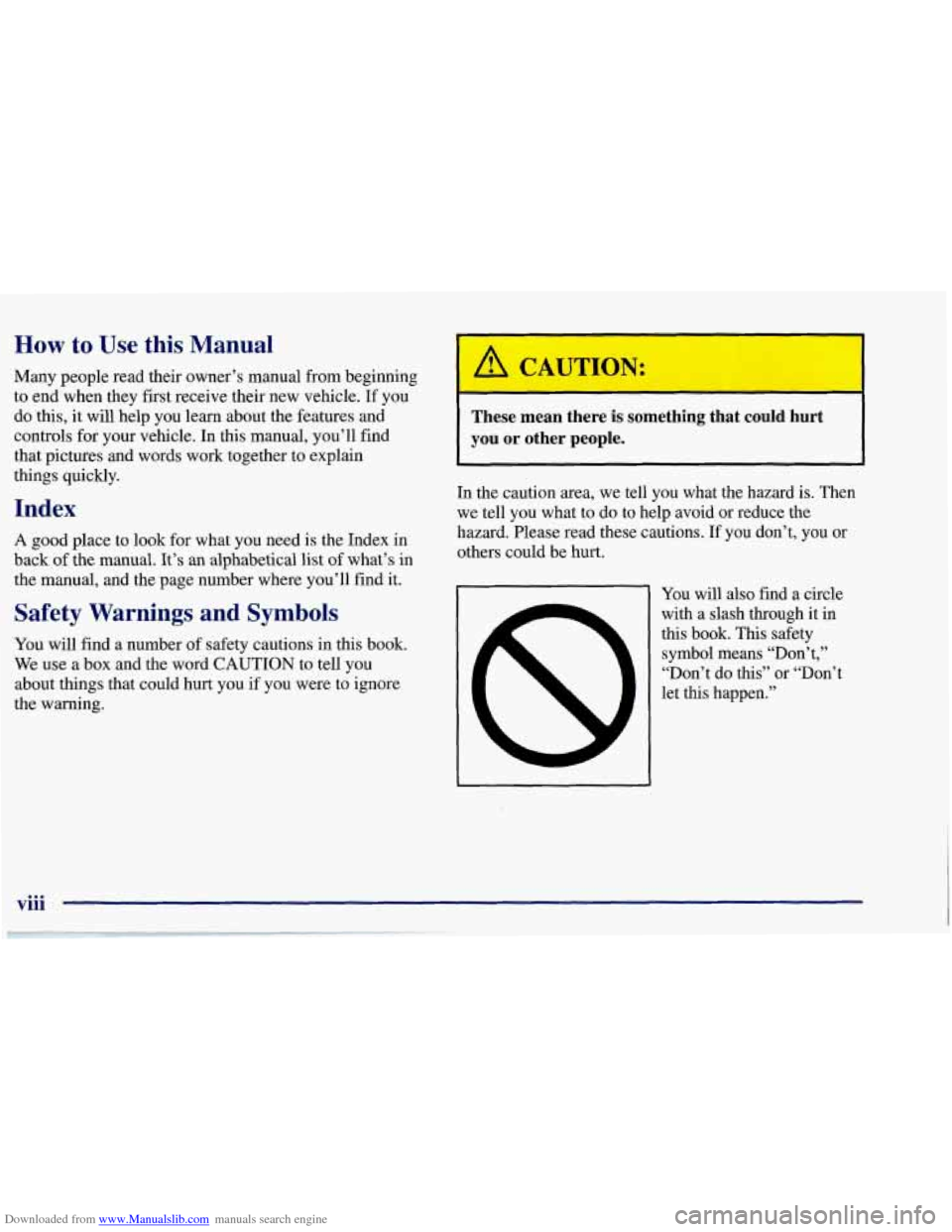
Downloaded from www.Manualslib.com manuals search engine How to Use this Manual
Many people read their owner’s manual from beginning
to end when they first receive their new vehicle. If you
do this, it will help you learn about the features and
controls for your vehicle. In this manual, you’ll find
that pictures and words work together to explain
things quickly.
Index
A good place to look for what you need is the Index in
back of the manual. It’s an alphabetical list
of what’s in
the manual, and the page number where you’ll find it.
W
These mean there is something that could hurt
you or other people.
In the caution area, we tell you what the hazard is. Then
we tell you what to do to help avoid or reduce the
hazard. Please read these cautions. If you don’t, you or
others could be
hurt.
Safety Warnings and Symbols
You will find a number of safety cautions in this book.
We use a box and the word CAUTION to tell you
about things that could hurt you if you were to ignore
the warning.
1 1
You will also find a circle
with a slash through it in
this book.
This safety
symbol means “Don’t,’’
“Don’t
do this” or “Don’t
let this happen.”
viii
Page 14 of 378
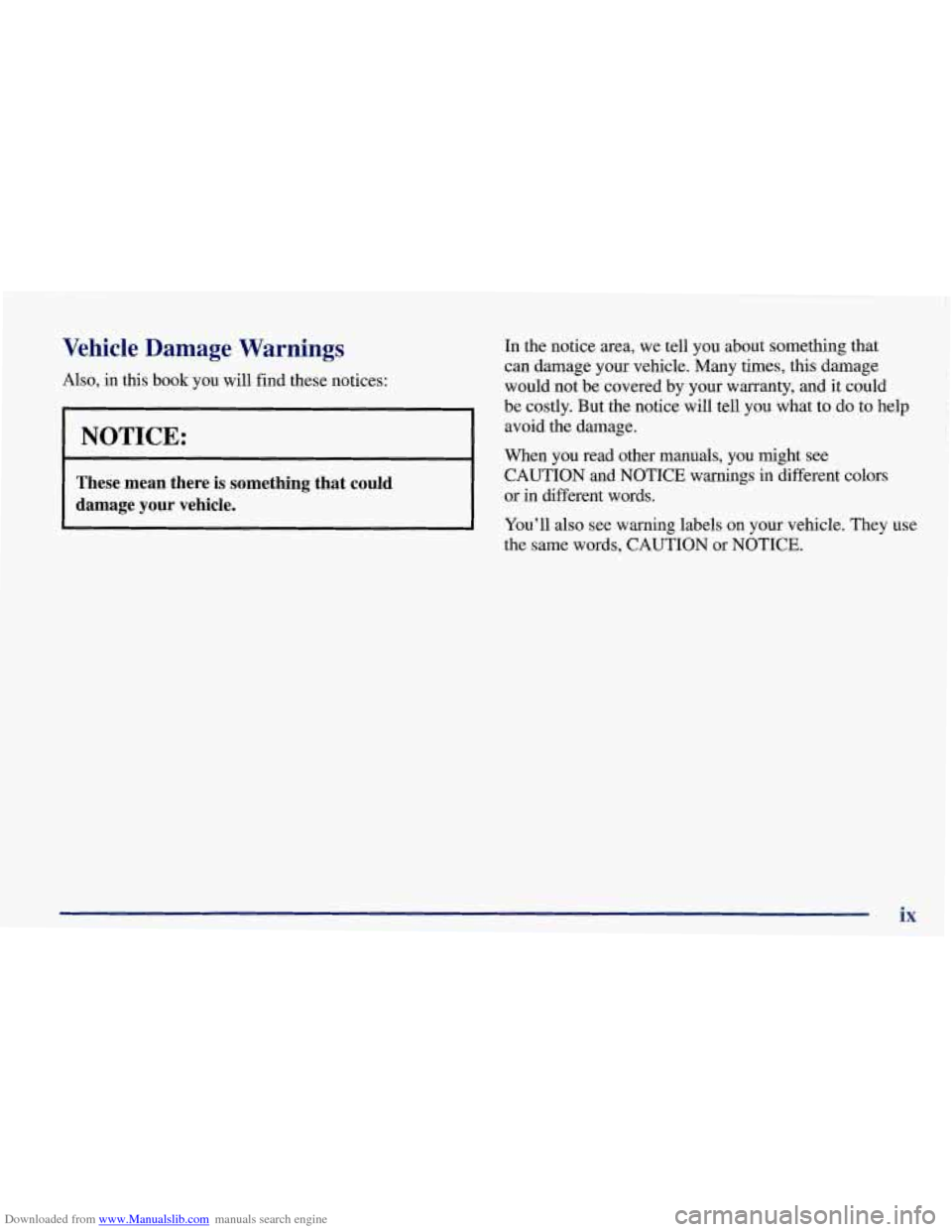
Downloaded from www.Manualslib.com manuals search engine Vehicle Damage Warnings
Also, in this book you will find these notices:
KNOTICE:
r
These mean there is something that could
damage your vehicle.
In the notice area, we tell you about something that
can damage your vehicle. Many times, this damage
would not be covered by your warranty, and it could
be costly. But the notice will tell you what to do to help
avoid the damage.
When you read other manuals, you might see
CAUTION and NOTICE warnings in different colors
or
in different words.
You’ll also see warning labels on your vehicle. They use
the same words, CAUTION or NOTICE.
ix
Page 15 of 378
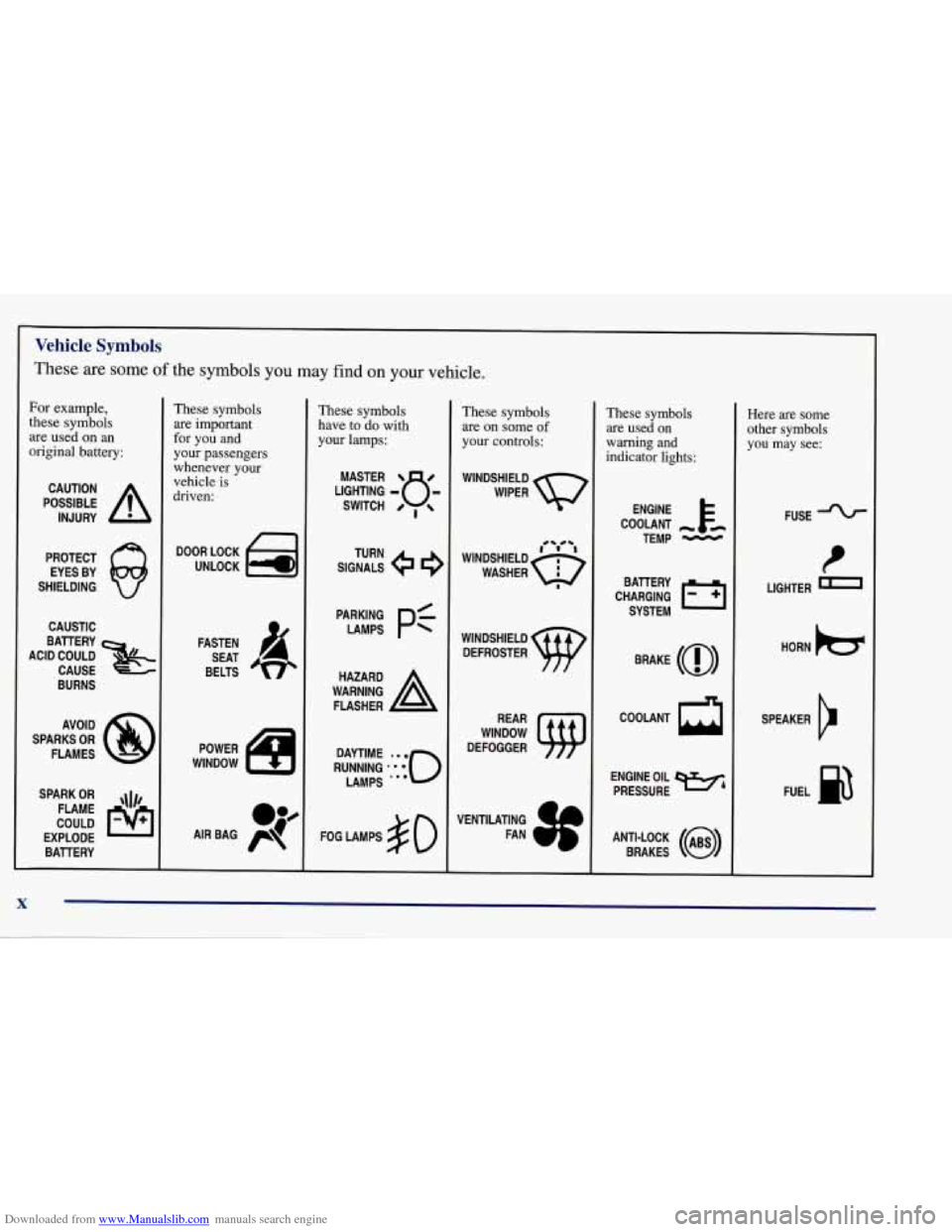
Downloaded from www.Manualslib.com manuals search engine Vehicle Symbols
These are some of the symbols you may find on your vehicle.
For example,
these symbols
are used on
an
original battery:
POSSIBLE A
CAUTION
INJURY
PROTECT EYES BY
SHIELDING
Q
CAUSTIC
These symbols
are important
for you and
your passengers
whenever your
vehicle
is
driven:
DOOR LOCK
UNLOCK
ACID COULD BAlTERY
CAUSE
BURNS
AVOID
SPARKS
OR
FLAMES
SPARK
OR ,\I/,
COULD FLAME
EXPLODE BAllERY FASTEN
SEAT
BELTS
These symbols
have
to do with
your lamps:
SIGNALS TURN
A
FLASHER
FOG LAMPS
$0
These symbols
are on some
of
your controls:
WINDSHIELD
DEFROSTER
WINDOW
DEFOGGER
VENTILATING FAN
These symbols
are used on
warning and
indicator lights:
COOLANT -
TEMP -
CHARGING I-1
BATTERY
SYSTEM
BRAKE
(@)
COOLANT
a
ENGINE OIL
PRESSURE
WA
ANTI-LOCK (@)
BRAKES
Here are some
other symbols
you may see:
FUSE
t
LIGHTER
HORN
b
SPEAKER
b
FUEL p3
X
Page 16 of 378
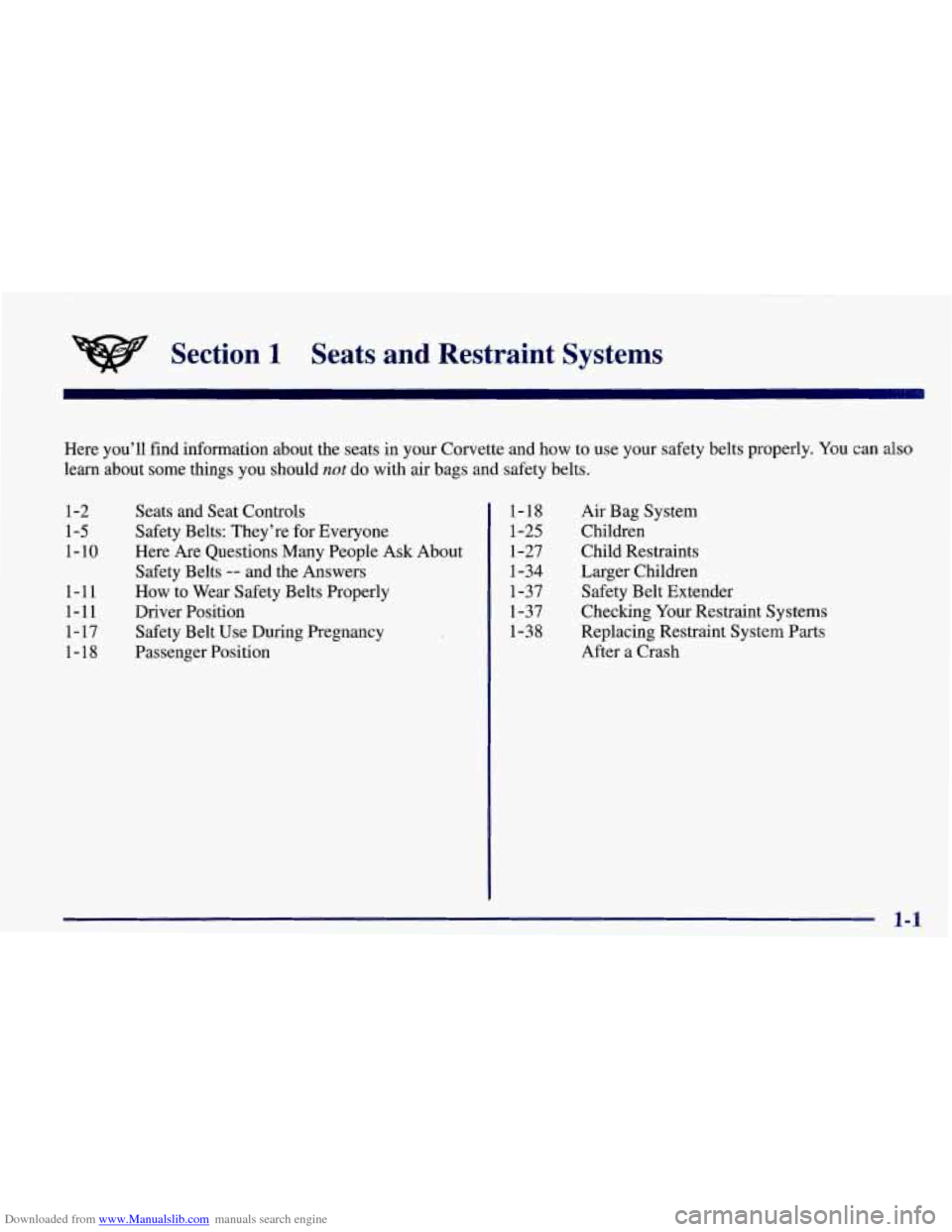
Downloaded from www.Manualslib.com manuals search engine Section 1 Seats and Restraint Systems
Here you’ll find information about the seats in your Corvette and how to use your safety belts properly. You can also
learn about some things you should not do with air bags and safety belts.
1-2 Seats and Seat Controls
1- 18 Air Bag System
1-5 Safety Belts: They’re for Everyone
1-25 Children
1
- 10 Here Are Questions Many People Ask About
Safety Belts
-- and the Answers 1-27 Child Restraints
After a Crash
1
- 18 Passenger Position 1-38
Replacing Restraint System Parts
1-17 Safety Belt Use During Pregnancy 1-37
Safety Belt Extender
1 - 11 How to Wear Safety Belts Properly 1-34 Larger
Children
1-11 Driver Position 1-37 Checking
Your Restraint Systems
1-1
Page 17 of 378
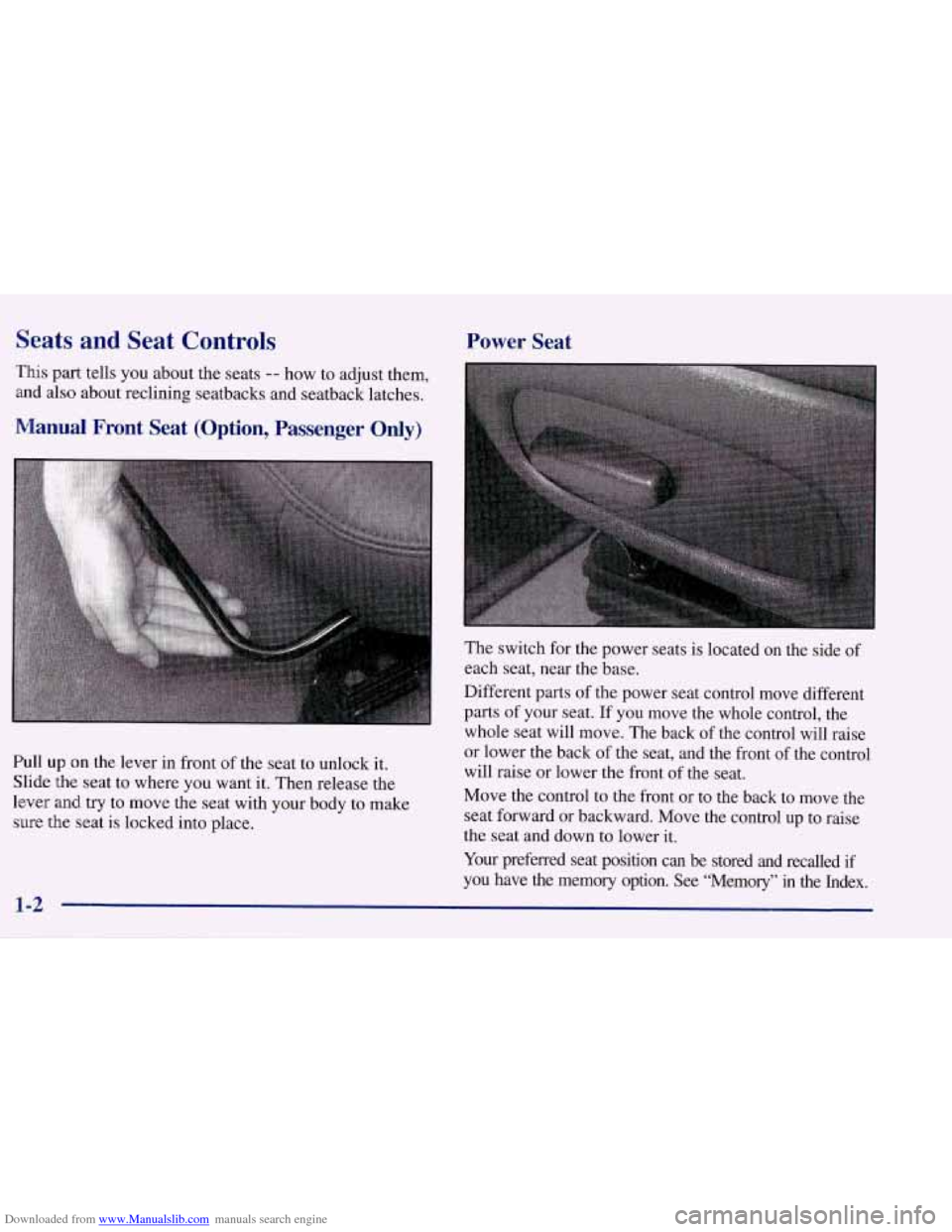
Downloaded from www.Manualslib.com manuals search engine Seats and Seat Controls Power Seat
This part tells you about the seats -- how to adjust them,
and also about reclining seatbacks and seatback latches.
Manual Front Seat (Option, Passenger Only)
Pull up on the lever in front of the seat to unlock it.
Slide the seat to where you want it. Then release the
lever and
try to move the seat with your body to make
sure the seat
is locked into place.
1-2
The switch for the power seats is located on the side of
each seat, near the base.
Different parts of the power seat control move different
parts
of your seat. If you move the whole control, the
whole seat will move. The back
of the control will raise
or lower the back
of the seat, and the front of the control
will raise or lower the front of the seat.
Move the control to the front or to the back to move the
seat forward or backward. Move the control up to raise
the seat and down to lower it.
Your preferred seat position can be stored and recalled if
you have the memory option.
See “Memory” in the Index.
Page 18 of 378
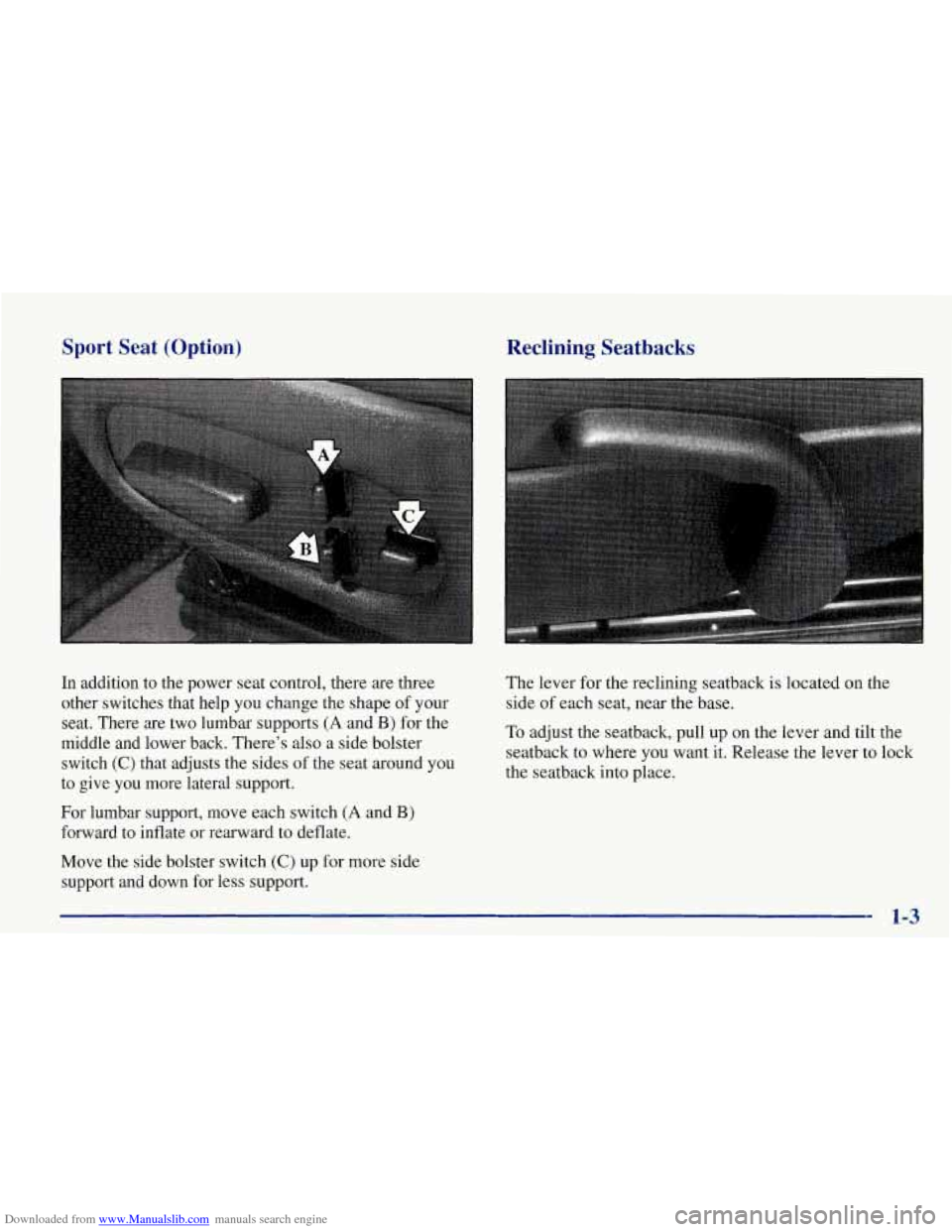
Downloaded from www.Manualslib.com manuals search engine Sport Seat (Option) Reclining Seatbacks
In addition to the power seat control, there are three
other switches that help
you change the shape of your
seat. There are two lumbar supports
(A and B) for the
middle and lower back. There’s also a side bolster
switch
(C) that adjusts the sides of the seat around you
to give you more lateral support.
For lumbar support, move each switch
(A and B)
forward to inflate or rearward to deflate.
Move the side bolster switch
(C) up for more side
support and down for less support. The lever
for the reclining seatback
is located on the
side
of each seat, near the base.
To adjust the seatback, pull up on the lever and tilt the
seatback to where
you want it. Release the lever to lock
the seatback into place.
1-3
Page 19 of 378
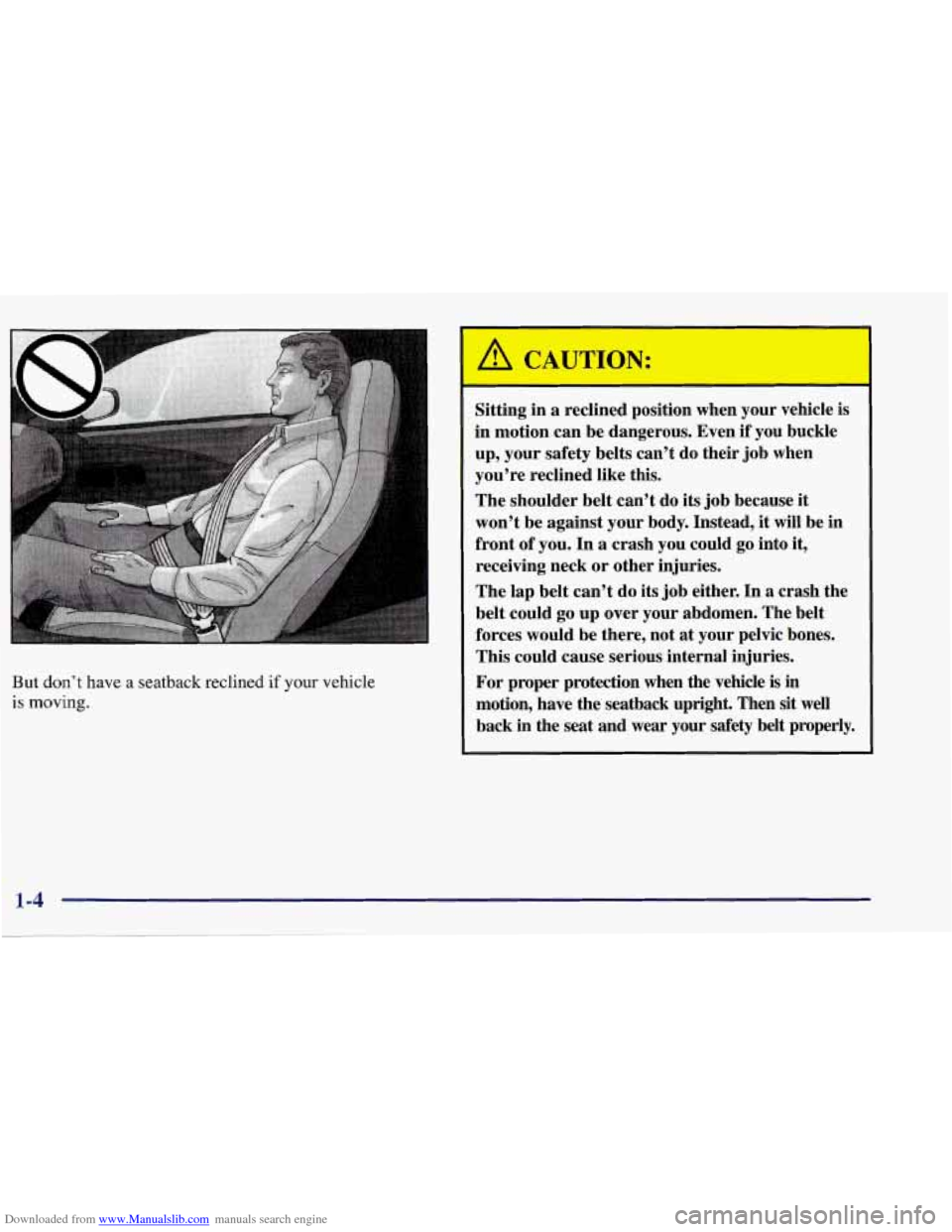
Downloaded from www.Manualslib.com manuals search engine But don’t have a seatback reclined if your vehicle
is
moving.
I Sitting in a reclined position when your vehicle is
in motion can be dangerous. Even if you buckle
up, your safety belts can’t do their job when
you’re reclined like this.
The shoulder belt can’t do its job because it
won’t be against your body. Instead, it will be in
front of you. In
a crash you could go into it,
receiving neck or other injuries.
The lap belt can’t do its job either. In a crash the
belt could
go up over your abdomen. The belt
forces would be there, not at your pelvic bones.
This could cause serious internal injuries.
For proper protection when the vehicle is
in
motion, have the seatback upright. Then sit well
back
in the seat and wear your safety belt properly.
Page 20 of 378
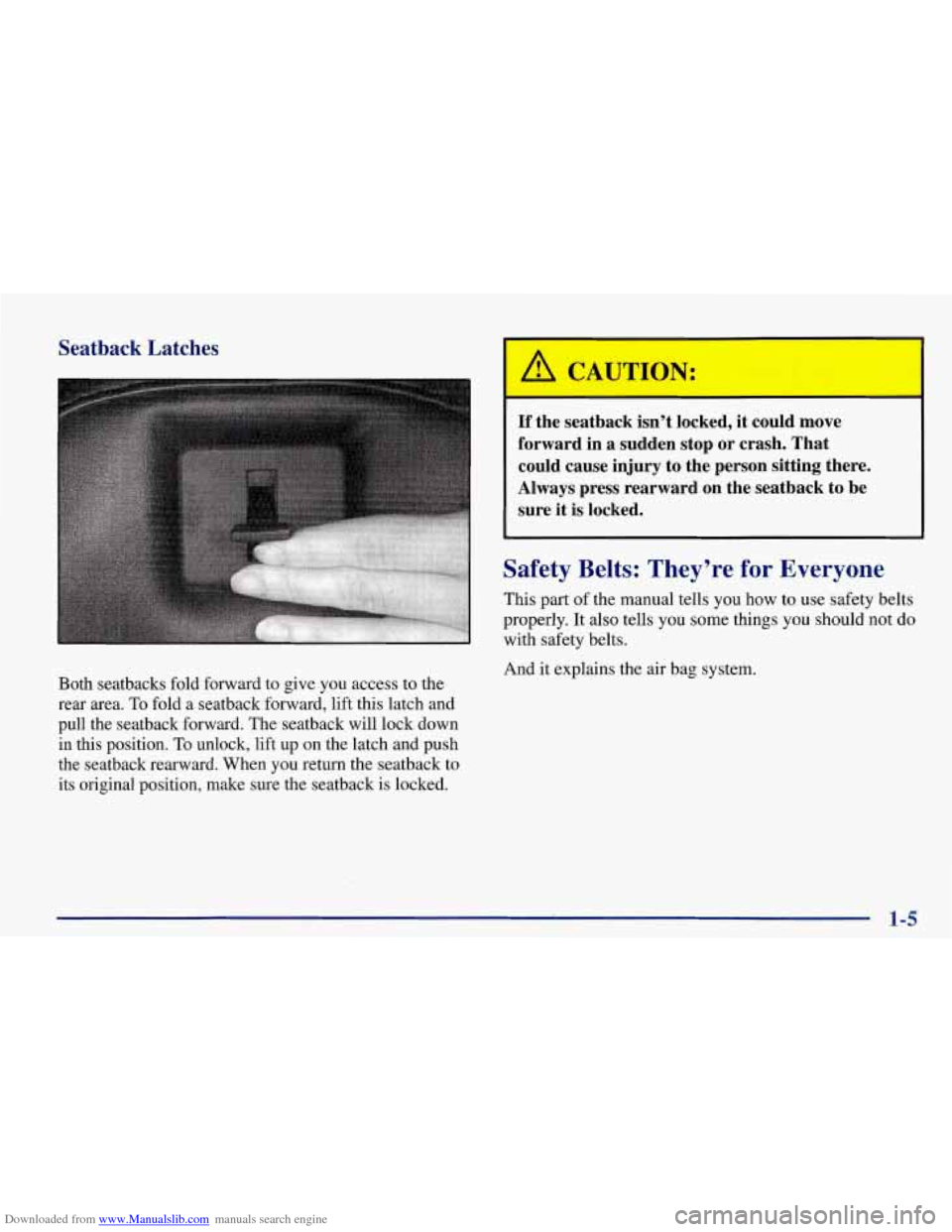
Downloaded from www.Manualslib.com manuals search engine Seatback Latches
I A CAUTION:
Both seatbacks fold forward to give you access to the
rear area.
To fold a seatback forward, lift this latch and
pull the seatback forward. The seatback will lock down
in this position.
To unlock, lift up on the latch and push
the seatback rearward. When you return the seatback to
its original position, make sure the seatback is locked.
If the seatback isn’t locked, it could move
forward in a sudden stop or crash. That
could cause injury to the person sitting there.
Always press rearward on the seatback to be sure it is locked.
Safety Belts: They’re for Everyone
This part of the manual tells you how to use safety belts
properly. It also tells you some things
you should not do
with safety belts.
And it explains the air bag system.
1-5